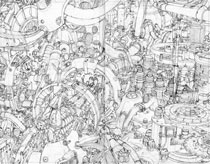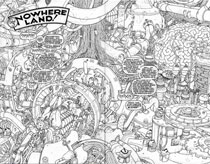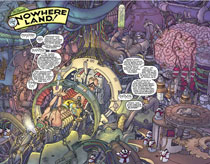You are here
Navigate the Nose
How to Make a Comic Page!
The following shows Seth's creative process, from pencils, inks, to colour. Below, Seth shares his thoughts on the development of this page and his creative process in general. Click on each image to see more, or View the animated process...
| Part 1: Rough out the page in pencil | Part 2: Re-trace the work in ink | Part 3: Add color |
 |
 |
 |
THE WILL BEHIND 'WILLWORLD'
Seth Fisher explains his artistic process regarding GREEN LANTERN: WILLWORLD
I wish I had some kind of super-secret to share with you about how I do a page. My pages are a delicate mixture of love and stress. Sometimes I do a few sketches to layout the panels and get the flow, though often times I just sit down and start drawing (and erasing). I like to approach my pages with the "infinite monkeys" theory of drawing (the theory goes, if an infinite number of monkeys had an infinite number of pencils and DC paper than one of them would produce the complete works of Sergio Arigones). Therefore, I figure if I just keep drawing, and then keep erasing, eventually something interesting will emerge from my page. The "Machineworks" page is one of my favorites from the book and I think it starts to illustrate my thought process. I often re-draw parts of panels after the pages have been lettered because the placement of the lettering can sometimes upset the balance of the page. For this particular page you can see some elements changed from the pencils to ink.
In this case I felt like the right hand page didn't have a strong enough focus. I had thought the text might provide that, but it didn't so I swapped stuff around. I do feel that inking is an important part of my problem solving and I am a little nervous that if I do a monthly book I won't get to ink my own stuff.
As for the coloring: Chris Chuckery colored these pages, and let me tell you that is no small feat. Most colorists I know really pride themselves on volume, sometimes cranking out 4 or more pages in a day. My stuff is such a pain to color that it probably takes them just as long to lay in the flat color as it does to completely color someone else’s page. Chris and I shot e-mails back and forth and kind of settled on a look for the book, and he was really willing to take his time to find the right look. The color is so important and can really make or break a story, so when I saw what Chris was doing I was really relieved to know this book was in good hands. His subtle subdued palettes are just stunning.
- Log in to post comments







